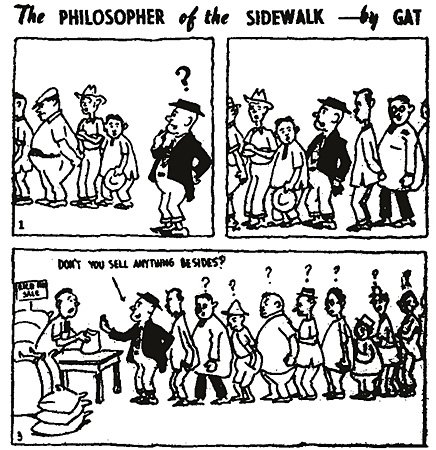Cultural Center of the Philippines
ENCYCLOPEDIA OF
PHILIPPINE ART
Philosopher of the Sidewalk
25 Jan 1942 / Artist: Liborio Gatbonton / Tribune
Liborio Gatbonton (1914-76) or Gat was one of the most prolific cartoonists in the postwar era. During the Japanese occupation, his comic strip The Philosopher of the Sidewalk was one of the four comic strips allowed by the Japanese censors to be published in the Tribune. The Philosopher of the Sidewalk was a silent cartoon that hardly had any dialogue and relied mainly on the nonverbal context of the narrative to deliver its message.
A comic strip of three panels came out on 25 Jan 1942 referring to food shortage during the occupation (Cheng Chue 2005, 77-8). The Philippines suffered from shortage of resources during the occupation, leading the Japanese to institute programs of rationing and substitution as a stopgap solution to the problem. Comic strips in the Tribune were used by the Japanese to promote these programs. These comic strips usually lauded the policy of substitution, promoting the use of readily available local products in place of imported goods.
It is interesting to note that in this particular comic strip, Gat created a counter-narrative that questioned the wisdom of these programs. In this comic strip, the philosopher is seen wondering why people were queuing. The next panel shows him joining the queue and the last one reveals the climactic phrase when the philosopher asks the vendor if he has anything else besides rice. In contrast to Gat’s style of illustrating before and after the Japanese occupation, this strip is devoid of the acerbic quality of many of his cartoons. Gat was known for his use of bold and dynamic lines and for the humorous and exaggerated facial expressions and body configurations of his characters. That the illustration in this strip seems tame is an indication of heavy censorship during this period. Nevertheless, the narrative content of this strip is a pointed criticism of conditions of the time, depicting the shortage of supplies that led to long queues and rationing. Therefore, not all cartoons published in the Japanese-sponsored paper were wholly used as propaganda, as artists like Gat were able, from time to time, to stoke the fire.
Written by Helen Yu-Rivera
Source
Cheng Chue, Karl Ian U. 2005. “The Stories They Tell: Komiks during the Japanese Occupation, 1942-1944.” Philippine Studies 53 (1): 59-90; 77-78.
